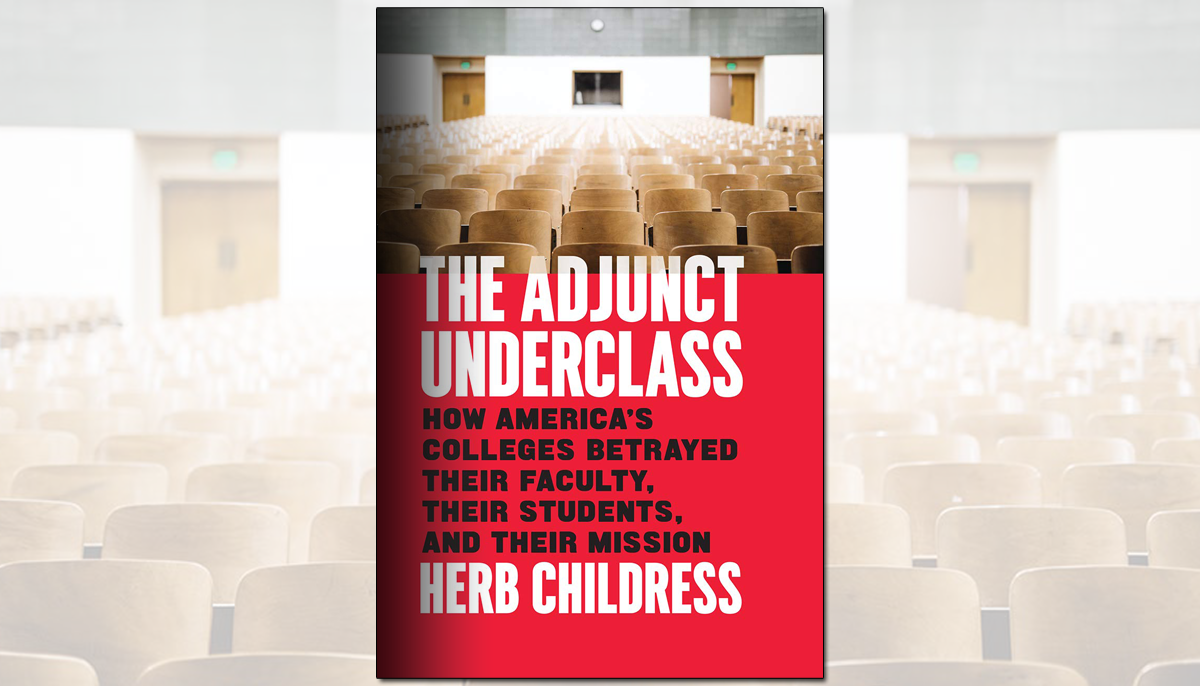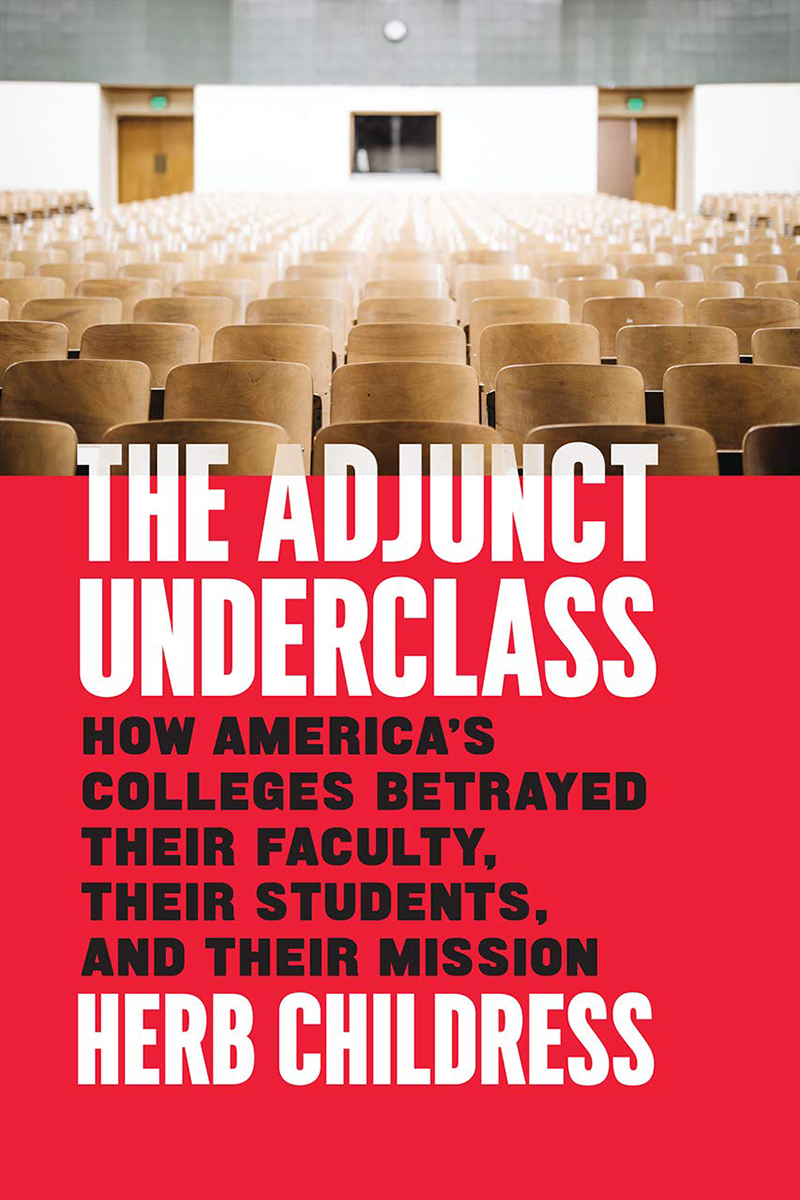
The Adjunct Underclass: How America’s Colleges Betrayed Their Faculty, Their Students, and Their Mission
by Herb Childress
University of Chicago Press, 2019, $24.00, 213 pages
As reviewed by Jenna A. Robinson
The plight of adjunct professors reads like a horror story. They drive hundreds of miles between campuses each week. They hold their “office hours” in the parking lot. They earn less than $30,000 with no benefits, despite working far more than 40 hours a week. These tales are so pervasive because they’re true, and Herb Childress has collected some of the most pitiful examples in his new book The Adjunct Underclass: How America’s Colleges Betrayed Their Faculty, Their Students, and Their Mission.
One story that Childress recounts originally appeared in the Pittsburgh Post-Gazette. In 2013, a former French instructor at Duquesne University died from cancer that she could not afford to treat. Margaret Mary Vojtko was 83 and lived in a home with no electricity, since she could not pay the bill. She had taught French at Duquesne for 25 years—earning less than $20,000 despite teaching at least six courses each year. As an adjunct instructor, she never received health benefits or retirement contributions.
Vojtko’s story is one of many. In The Adjunct Underclass, Childress makes the argument that non-tenure-track faculty are overworked, underpaid, and symptomatic of a hidden class struggle in the academy. His argument, however, is not always convincing.
In the first chapter of his book, Childress asserts that “college teaching has become primarily a pickup job, like driving for Uber or running chores for TaskRabbit.” He backs that up by lumping adjuncts, full-time non-tenure-track faculty, and graduate teaching assistants into the same category and showing that they carry most of the teaching load. Childress then detours into a description of American higher education through the lens of social class. He derides the higher-education system for its stratification, lamenting the fact that community colleges and trade schools serve different students and have different goals than highly competitive public and private universities.
As a contrast to this critique, he offers a sober analysis of both the sources of the adjunct workforce (too many PhD-granting programs and the unfitness of “critical intellectuals” for non-academic work) and the growth of administration. He notes that there has been a large increase in professional positions in a variety of university offices “as the business of higher education has become increasingly complex.”
The rest of the book follows this pattern: recasting campus problems and people as part of a larger class struggle and interspersing this recasting with important and accurate observations about serious problems in higher education.
 One of those problems cuts to the heart of the adjunct conundrum: In any given year, universities produce about ten times more PhD graduates than available tenure-track faculty positions. They do this to increase their prestige. Appendix A, which details the 14 separate causes to which Childress attributes the adjunctification of faculty, is especially interesting in this context.
One of those problems cuts to the heart of the adjunct conundrum: In any given year, universities produce about ten times more PhD graduates than available tenure-track faculty positions. They do this to increase their prestige. Appendix A, which details the 14 separate causes to which Childress attributes the adjunctification of faculty, is especially interesting in this context.
Though Childress is right to draw attention to the problems of salary, job security, and borderline exploitation that sometimes characterize adjunct employment, his attempt to cast “adjunctification” as a grand class struggle is an overreach, and his solutions are unworkable and expensive.
The adjunct “crisis” affects far fewer professors and institutions than Childress implies. Postdoctoral fellows and other full-time non-tenure-track faculty should not be lumped with adjunct professors when considering questions of pay and prestige. Data from my own state are illustrative: adjuncts are not representative of all non-tenure-track faculty. In the University of North Carolina system, the median salary of a post-doctoral fellow is $47,500. One lecturer in the accountancy department at UNC-Wilmington earns $125,000 per year. The median for all lecturers in the UNC system is $50,303. This is a far cry from the adjunct professor earning $2,700 per course.
Further, “Estimating the Cost of Justice for Adjuncts: A Case Study in University Business Ethics,” a recent study by Jason Brennan and Phil Magness, demonstrates that there has been no precipitous “adjunctification” of the faculty at most colleges and universities. When for-profit campuses are excluded from the picture, American universities have maintained a stable ratio of about one full-time professor to every 25 students.
Childress’ oversimplification of types of institutions and non-tenure-track faculty—as well as his fixation on social class—detracts from his thoughtful observations about higher education. It isn’t necessary to convince readers that academia has become a gig-economy hellscape in order to point out its flaws.
Childress’ solution, which he admits is utopian, is equally problematic. He laments, for example, that American higher education is “pulled in dozens of competing directions at once” and that many colleges offer “infinite choice wrapped around a hollow core.” He wants every college and university to become the kind of place that enriches its students far beyond mere knowledge acquisition. He takes as his model Loren Pope’s description of Colleges That Change Lives:
Students and teachers develop a mentor relationship in class, and professors become students’ hiking companions, intramural teammates, dinner hosts and friends. Learning is collaborative rather than competitive; values are central, community matters.
This would mean adding substantially to the ranks of full-time tenure-track faculty. Which, however much Childress exaggerates the problem, would be massively expensive at a time when rising tuition costs are already a major concern. It’s not clear where Childress would have the money come from, except perhaps from increased government subsidies.
It would also mean that many colleges would have to radically change their missions. Childress calls such places “colleges that leave you more or less the way you were, but teach you to be a nurse” and “colleges that get you ready to go to another college.” But that’s what a large majority of students want. According to the Higher Education Research Institute’s annual freshman survey, most students are in college “to be able to get a better job.” Less than half want to “become more cultured.” Colleges that change lives have an important role to fill, but only a small number of students will ever want or appreciate what they have to offer.
Childress’ somewhat tongue-in-cheek suggestion that colleges name themselves more accurately (“a trade school, a federal research laboratory, an NBA training camp, or a young adult daycare center”) has more potential to improve higher education. A “great unbundling” is long overdue. It wouldn’t add to the cohort of tenure track faculty, however, which is Childress’ primary goal.
Once Childress moves past his utopian vision, he offers excellent and humorous advice to students considering academic careers. His last chapter includes a “useful scale to help graduate-student readers…understand their pending academic careers.” The tool ultimately guides students to go to graduate school only if they can get into a top 20 school worldwide in their chosen discipline, present their research at a major national conference, and finish by the time they are 30. He also includes some relevant guidance about dissertation advisors, publication, and recommended terminal degree (PhD, if you want to be taken seriously).
This advice addresses the real issue: oversupply of willing adjunct labor. If all students were to take Childress’ recommendations to heart, far fewer of them would go to graduate school in the first place, and the problem of “adjunctification” would solve itself. And I hope students do start making different choices—because universities benefit too much from the status quo to make any changes on their own.
Jenna A. Robinson is president of the James G. Martin Center for Academic Renewal.


